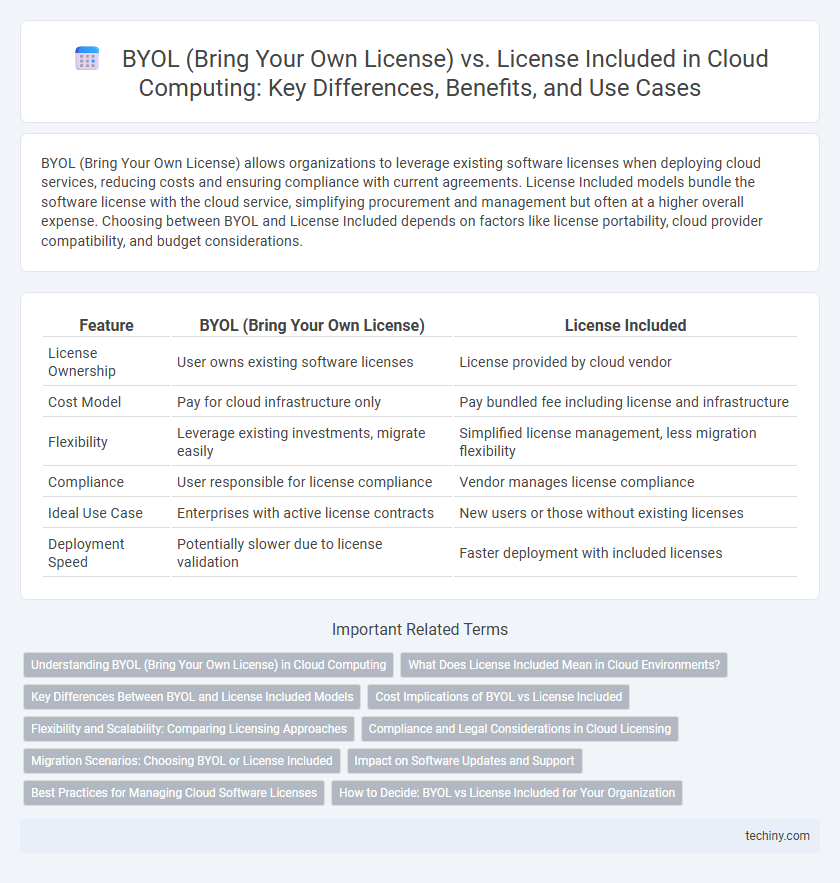BYOL (Bring Your Own License) allows organizations to leverage existing software licenses when deploying cloud services, reducing costs and ensuring compliance with current agreements. License Included models bundle the software license with the cloud service, simplifying procurement and management but often at a higher overall expense. Choosing between BYOL and License Included depends on factors like license portability, cloud provider compatibility, and budget considerations.
Table of Comparison
| Feature | BYOL (Bring Your Own License) | License Included |
|---|---|---|
| License Ownership | User owns existing software licenses | License provided by cloud vendor |
| Cost Model | Pay for cloud infrastructure only | Pay bundled fee including license and infrastructure |
| Flexibility | Leverage existing investments, migrate easily | Simplified license management, less migration flexibility |
| Compliance | User responsible for license compliance | Vendor manages license compliance |
| Ideal Use Case | Enterprises with active license contracts | New users or those without existing licenses |
| Deployment Speed | Potentially slower due to license validation | Faster deployment with included licenses |
Understanding BYOL (Bring Your Own License) in Cloud Computing
BYOL (Bring Your Own License) in cloud computing allows organizations to use existing software licenses on cloud platforms, reducing licensing costs and maximizing investments. This model provides flexibility to migrate legacy applications while maintaining compliance with vendor license terms. BYOL is especially beneficial for enterprises with complex licensing agreements or specialized software needs that are incompatible with License Included offerings.
What Does License Included Mean in Cloud Environments?
License Included in cloud environments means the cloud provider bundles the software license with the computing resources, simplifying deployment and billing by covering licensing costs in the service fee. This model eliminates the need for customers to manage separate software licenses or compliance, ensuring seamless access to licensed software like operating systems or databases. It enables faster provisioning and predictable expenses, making it ideal for organizations seeking turnkey cloud solutions without upfront license investments.
Key Differences Between BYOL and License Included Models
BYOL (Bring Your Own License) allows organizations to leverage existing software licenses in cloud environments, reducing additional licensing costs while requiring license compliance management. License Included models provide cloud providers' software licenses bundled with infrastructure costs, simplifying deployment and support but increasing overall expenses. Key differences include cost structure, licensing flexibility, and responsibility for license management and compliance.
Cost Implications of BYOL vs License Included
BYOL (Bring Your Own License) can significantly reduce cloud computing costs by allowing businesses to leverage pre-existing software licenses, avoiding the higher expenses associated with License Included models where software costs are bundled into cloud service fees. License Included options offer predictable pricing and simplified management but often come with premium costs that may not align with organizations holding bulk or enterprise licenses. Evaluating factors such as existing license investments, compliance requirements, and long-term scalability is essential for optimizing cost efficiency in cloud deployments.
Flexibility and Scalability: Comparing Licensing Approaches
BYOL grants organizations greater flexibility by allowing the use of existing software licenses across various cloud environments, reducing dependency on vendor-specific pricing models. License Included models simplify scalability by bundling software licenses with cloud service costs, enabling rapid deployment without additional licensing management. Choosing between BYOL and License Included hinges on balancing cost efficiency, operational control, and the ability to scale dynamically based on organizational needs.
Compliance and Legal Considerations in Cloud Licensing
BYOL (Bring Your Own License) requires strict adherence to vendor-specific compliance terms to ensure licenses remain valid in cloud environments, preventing legal risks associated with unauthorized use. License Included models simplify legal considerations by bundling the license with cloud service subscription, transferring compliance responsibilities to the cloud provider. Enterprises must assess contract terms, audit rights, and jurisdictional regulations to avoid penalties and maintain software legitimacy across cloud deployments.
Migration Scenarios: Choosing BYOL or License Included
Migration scenarios in cloud computing require careful consideration between BYOL (Bring Your Own License) and License Included models to optimize cost and compliance. BYOL allows enterprises to leverage existing licenses, reducing upfront expenses while maintaining licensing flexibility, particularly for legacy applications migrating to hybrid or multi-cloud environments. License Included simplifies migration by bundling software licenses with cloud services, ideal for quick deployment and minimizing licensing management overhead during large-scale moves.
Impact on Software Updates and Support
BYOL (Bring Your Own License) allows organizations to maintain control over software updates and support schedules, often aligning with existing enterprise agreements and ensuring customized update policies. License Included models streamline access to automatic software updates and vendor-managed support, reducing administrative overhead but potentially limiting update customization. The choice impacts flexibility in update timing and the level of direct vendor support, influencing operational continuity and compliance in cloud environments.
Best Practices for Managing Cloud Software Licenses
Effective management of cloud software licenses involves comparing BYOL (Bring Your Own License) with License Included models to optimize cost and compliance. BYOL enables leveraging existing on-premises licenses in the cloud, reducing license duplication and maximizing ROI, but requires careful tracking to avoid compliance risks. License Included offers simplified license management with predictable costs and vendor support, ideal for dynamic or short-term workloads that benefit from flexible scaling without upfront license investments.
How to Decide: BYOL vs License Included for Your Organization
Choosing between BYOL (Bring Your Own License) and License Included models depends on your organization's existing software investments and licensing agreements. BYOL offers cost-efficiency for businesses with pre-purchased licenses and established compliance, while License Included simplifies management by bundling software and cloud costs into a single subscription. Evaluate factors such as total cost of ownership, vendor flexibility, and compliance requirements to determine the optimal licensing strategy for your cloud environment.
BYOL (Bring Your Own License) vs License Included Infographic

 techiny.com
techiny.com